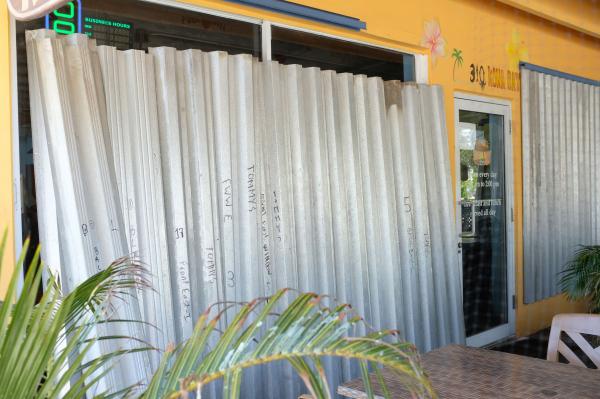
Sept. 7 (UPI) — With Hurricane Irma just a couple days out, Florida’s 20 million residents are hitting highways out of town — and those who aren’t leaving are searching for supplies to hunker down.
State residents are bracing for the strongest storm since Hurricane Andrew, a Category 5 storm, struck South Florida in 1992. Andrew caused $47.8 billion in damage and killed 65. Irma is forecast to diminish to a Category 4, which is sustained winds of 130-156 mph, when it possibly reaches Florida sometime overnight Saturday.
But Gov. Rick Scott said Thursday that Irma is “much worse and more devastating on its current path” than Andrew.
“Andrew didn’t have storm surge, but this storm does,” Scott said during a briefing at Hialeah’s Emergency Operations Center. “This can kill you.”
The National Hurricane Center hasn’t issued a storm surge forecast yet for South Florida but it predicts “life-threatening storm surge and large breaking waves” of 15 to 20 feet in southeastern and central Bahamas and 5 to 10 feet in the northern coast of Cuba.
The NHC at 11 a.m. issued a storm surge watch and hurricane watch for South Florida — stretching from the Jupiter Inlet south around the peninsula’s southern tip to Bonita Beach on the gulf coast. The Florida Keys are also included in both watches.
“The cone has our entire state. And this thing is bigger than our entire state right now. So take this seriously, have a plan,” Scott said.
Mandatory evacuations have already been issued in coastal areas of South Florida, including the Florida Keys and more than 100,000 Miami-Dade residents on barrier islands, including Miami Beach, and in low-lying mainland areas starting Thursday morning. The county planned to have eight shelters open Thursday.
In Brevard County, 188 miles north of Miami, mandatory evacuations were ordered Friday in low-lying areas and barrier islands.
Broward County, which includes Fort Lauderdale, ordered coastal and low-lying neighborhoods evacuated Thursday and planned to open 14 shelters later in the day.
Palm Beach County didn’t order any evacuations but plans to open 15 shelters Friday morning.
Many of the shelters are in schools. Students and teachers from kindergarten through college are not in school Thursday and Friday. Businesses are giving employees the rest of the week off to prepare for the storm or leave town.
Many of the 6.7 million residents in South Florida are filling the two main highways out of the area — the Florida Turnpike and Interstate 95.
The Florida Highway Patrol said Thursday morning there was a “high volume” of traffic along Florida’s Turnpike. Troopers also have noticed disabled and abandoned vehicles along the highway.
“Any vehicle left disabled or abandoned along the Florida Turnpike will be towed off the roadway,” Sgt. Mark Wysocky said.
The state has decided not to open the southbound turnpike lanes for northbound traffic, and instead is allowing free use of shoulders, toll-free express lanes and toll roads to reduce the potential for crashes, emergency managers said.
Traffic volume has also increased on I-95, according to the Florida Emergency Operations Center’s real-time traffic counters.
Fuel shortages are another problem as people top off their tanks and fill gas containers.
Lines were long for stations with gas — and at stations with plastic bags placed over empty pumps, drivers waited for tankers to arrive.
“Right now, people are buying gas five times faster than normal,” John Jamason, Palm Beach County’s deputy director of public affairs, said at a media briefing Wednesday. “It’s not that there’s an actual shortage of fuel. The state says there’s plenty of fuel, and everything is coming through Port Everglades.”
Scott said, “We’re moving as much fuel through the system as fast as possible.”
He said the state has waived weight limits and other restrictions on fuel trucks.
“We need to see what or if there are any solutions to get that fuel out there faster,” Florida Division of Emergency Management Director Bryan Koon said at the Thursday briefing with Scott.
He described it as a “tremendous” issue.
“At any time, there is a seven-day supply of gas in the state,” said James Miller, spokesman for the Florida Petroleum Marketers and Convenience Store Association. “All ports are open and gas continues to be shipped to Florida, and petroleum retailers are coordinating among each other to ensure adequate supplies for all regions of the state.”
Customers can search for stations that have gas at tracker.gasbuddy.com.
Other options to leave town are limited.
Key West International Airport announced it would close after the last commercial flight Thursday night, and other airports plan to wind down operations by Friday afternoon. Airport operations close down when winds hit 55 mph.
Delta Air Lines, which has a major hub in Miami, added flights from the city, Palm Beach, Fort Lauderdale and Key West into Atlanta.
Some airlines are trying to avoid dramatically increased fares. JetBlue Airways is offering $99 direct flights from every Florida city where it operates, the airline said.
Greyhound, Amtrak, local rail lines and cruise ships plan to stop service at least 24 hours before the storm arrives, or if winds exceed 35 mph.
Carnival, Norwegian and Royal Caribbean each have canceled two cruises out of South Florida ports.
For those staying in Florida, food, plywood to board windows and propane for grills were in short supply. Even shelves for water at grocers and convenience stores were bare.
In Florida, it is unlawful to sell commodities, including gasoline, that “grossly exceeds the average price for that commodity during the 30 days before the declaration of the state of emergency” unless it can justify market trends.
Florida Attorney General Pam Bondi said Wednesday night there were more than 1,500 reported incidents of price-gouginge, including delivery charges of $100 for one case of water.
“You’ve got vendors trying to trick people,” Bondi said. “It’s sickening and disgusting and we’re not going to have it.”
Walmart is moving water from distribution centers as far away as Nevada and deploying 1,360 semi-truck loads.
The American Red Cross and the Federal Emergency Management Agency were preparing to assist with residents’ needs after the storm.
President Donald Trump posted on Twitter Thursday morning, “Hurricane Irma is raging but we have great teams of talented and brave people already in place and ready to help. Be careful, be safe!”





